I don't know well about macarons....until I've found out that...
Macarons are actually a very colourful french pastry that are usually made of egg whites, almond powder, icing sugar and sugar.
It's a real yummy food to eat...
Take me to France or Paris please....
Buy me that please.....
Pictures from www.maisonblanc.co.uk/
More about Macoron....
History of Macoron
In the early 1930 the bakery Ladurée in Paris started selling two traditional dome halves sandwiched with a sweet filling between. This resulted in giving the new macaron , the possibility of flavored garnishes, and a newfound moistness that came from the garnish. Whereas the traditional macaron was sweet and dry and crunchy, the new macaron had the added attraction of being delicately crunchy on the outside, while moist, chewy, and flavourful on the inside.
White...Pink...Green...White...
Pictures from www.slashfood.com
It's another macorons
Pictures from www.sirha.com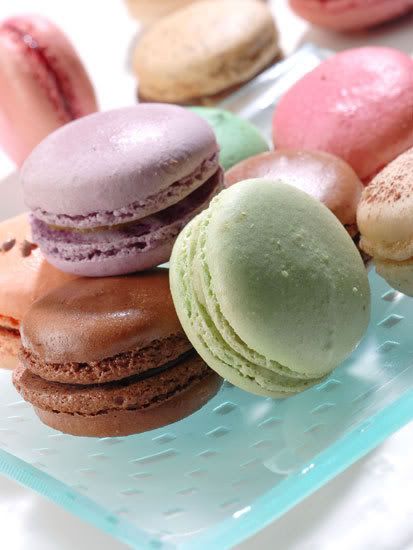
Yum Yum....

Pyramid macarons?
Green with tomato...I wonder how it tastes like...
You're torturing me!!!Stop showing this to me!!
Pictures from www.roussel-chocolatier.com/
It's the triplets...
Pictures from www.dbarbosa.net/dc/images/culinaire/macarons.jpg
Macaron The French Pastry
Cookies
Everybody's lazy to read blogs...
So do I...lolz
So...instead of alot of words....I put lots of pictures in my blog...muahahaha
Enjoy the cookies pictures....
I really want to have these....
Personalized your cookies....
http://www.jamiesjumpingjacks.com/
Seseme street???It's red and green???Can I have that cookie pleaseee.....
Chip chip....Chicky...
Yeah!!Teddy!!!
Amour de cookies...
oooo...Chubby the Bear...Chub Chub
Butterfly kisses...Muah...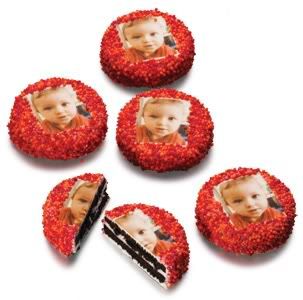
Baby??I don't dare to eat it...
Chocolate moist cake
I felt boring to search infos about every food in my blog....
So I thought....instead of blogging infos about food...why don't I just post nice pictures for you to view??
Yum Yum!!
Berries and Chocolate!!
Cinnamon Chocolate cake...
Good Luck cake brings you fortune...lolz
Recipe
CHOCOLATE MOIST CAKE
2 c. flour
1 1/2 cups sugar
1 tsp. salt
1 tsp. baking powder
2 tsp. baking soda
3/4 c. cocoa
1 c. oil
1 c. hot coffee
1 c. milk
2 eggs
1 tsp. vanilla
FROSTING:
1 pkg. cream cheese
1 tbsp. milk
1 1/2 c. powdered sugar
Combine all ingredients except black hot coffee. Mix. Add hot coffee. Batter will be thin. Pour into 9x13 pan. Bake 30 minutes at 375 degrees.
When cooled, combine cream cheese, milk and powdered sugar. Frost then serve.
It's another chocolate.
Oh...My...love...My darling...I'm hunger for...your...Taste!!
Don't wanna gain weight...Why not try this recipe??
Secret recipe's sugar free chocolate moist recipe...
http://www.secretrecipe.com.my/secretrecipe/catalog/exchange/c4364.html
Creamy and rich Belgian coverture chocolate and white chocolate filling.Oh please,let me have it on my birthday!!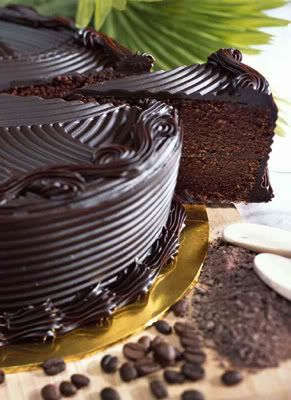
I don't mind to have 2 cakes on my birthday...lolz...
That's so "HOT POT"!!
I like steamboat...
I'm planning to go for a steamboat dinner on the 31st of December with friends...
That's actually because i'll be celebrating my birthday there...
Steamboat (food)
It has been suggested that this article or section be merged into Hot pot.
Raw meats ready to be cooked.
Steamboats refer to a variety of dishes eaten throughout East Asia, where ingredients are cooked in a simmering pot of broth at the table, usually communally, similar to a fondue.
Typical steamboat ingredients include thinly sliced meat, leafy vegetables, mushrooms, tofu, noodles or seafood. The cooked food is either eaten with a dipping sauce, or sometimes as a soup.
In many areas, steamboats are often eaten in the winter.
Is it necessary to have steamboat dinner?
The answer is......
A YES!!
Because its have got so many ingredients!!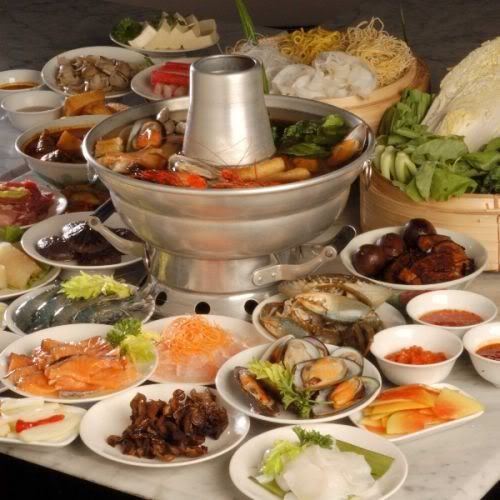
Common ingredients-
Basic stock is often made using:
-Water
-Salt
-Soup
And bones of either:
-Beef
-Chicken
-Ox
Meats vary, and can include:
-Thinly sliced beef, pork, chicken, lamb, goat
-Fish pieces
-Prawns
-Scallops
-Mussels
Coagulated pork blood (I don't like it anyway)
-Meatballs
-Fish balls
-Offal, ear and other delicacies
-Squid
-Cuttlefish
Vegetables include:
-Napa cabbage (or bo choy)
-Choy sum
-Garland chrysanthemum (tong ho)
-Snake beans
-Mung bean sprouts
-Shallots
-Varieties of mushrooms
-Ginger
-Tofu
-Thinly sliced potatoes
-Taro
-Tomato
-Niangao
-Varieties of noodles
Condiments:
-Hoisin sauce
-Soy sauce
-Sesame oil
-White pepper
-Satay (or Sha Cha) Sauce
-Chili
-Sesame butter
-Peanut butter sauce, made by mixing peanut butter with water to a thick consistency (or hua sheng ru fu)
The hot pot steamboat is actually originated from Beijing...
In Beijing (Peking), hot pot is eaten year-round. Typical Beijing hot pot is eaten inside during the winter. Different kinds of hot pot can be found in Beijing - typically, more modern eateries offer the sectioned bowl with differently flavored broths in each section. More traditional or older establishments serve a fragrant, but mild, broth in the hot pot, which is a large brass vessel heated by burning coals in a central chimney. Broth is boiled in a deep, donut-shaped bowl surrounding the chimney.
The Manchurian hot pot (Traditional Chinese: 東北酸菜火鍋) uses plenty of Suan cai (Chinese sauerkraut) (Traditional Chinese: 酸菜; pinyin: suan cai) to make the pot's stew sour.
One of the most famous variations is the Sichuan or Szechuan "má là" (Traditional Chinese: 麻辣 — "numb and spicy") hot pot, to which a special spice known as huā jiāo (Traditional Chinese: 花椒 — "flower pepper" or Sichuan Pepper) is added. It creates a sensation on the tongue that is both spicy and burns and numbs slightly, almost like carbonated beverages. It was usual to use a variety of different meats as well as sliced mutton filet. A Sichuan hotpot is markedly different from the types eaten in other parts of China. Quite often the differences lie in the meats used, the type of soup base, and the sauces and condiments used to flavor the meat. The cities of Chengdu and Chongqing are also famous for their different kinds of huǒ guō. "Sì Chuān huǒ guō" could be used to distinguish from simply "huǒ guō" in cases when people refer to the "Northern Style Hot Pot" in China. "Shuān yáng ròu", Chinese: 氽羊肉 (instant-boiled lamb) could be viewed as representative of this kind of food, which does not focus on the soup base.
In Xishuangbanna, Yunnan Province in southwestern China near the border with Myanmar, the broth is often divided into a yin and yang shape - a bubbling, fiery red chilli broth on one side, and a cooler white chicken broth on the other.
In Taiwanese hot pot, people eat the food with a dipping sauce consisting of sacha sauce and raw egg yolk.
In Thailand, hotpot is called "sukiyaki", although it is quite different from Japanese-style sukiyaki. A sauce, often mixed with broth from the hot pot, is based on tofu, sesame seed oil, chilis, and garlic.
one of the steamboat restaurant in Ipoh!!Oh Yeah!!Ipoh!!
Muahaha!!It's foooooood!!But it's still raw...
Another Yes for me to have steamboat!!Yeah!!Steamboat!
Chocolatte!!
Chocolate??
Everybody knows chocolates...
But I don't think you know chocolates can appeared in fashion shows...
Chocolate or high heeled??It's chocolate heeled shoes!!
I can't believe this!!Chocolate hairstyle!!??Eww!!
A model walks down the runway wearing a chocolate inspired dress called Little Shop of Horrors by chef Martin Howard.
A model walks down the runway wearing a chocolate inspired dress called Chocolate Chai by chefs Colleen Apte and Steve Klc.
Designers help models into their chocolate outfits before the show.
A model walks down the runway wearing a chocolate inspired dress by chef Larry Ebel.
A model walks down the runway wearing another of chef Larry Ebel's chocolate creations.
History of chocolate
The history of chocolate is very diverse from its naming to its creation.
Etymology
The name chocolate most likely comes from the Nahuatl language, indigenous to central Mexico, although it may have been influenced by the Mayan languages. One popular theory is that it comes from the Nahuatl word xocolatl (IPA /ʃo.ko.latɬ/) derived from xocolli, bitter, and atl, water.[1] (Xocolatl was a chocolate drink consumed by the Aztecs, associated with the Mayan god of Fertility). Alternate derivations include that of the Mexican philologist, Ignacio Davila Garibi, who proposed that "Spaniards had coined the word by taking the Maya word chocol and then replacing the Maya term for water, haa, with the Aztec one, atl." The Maya verb chokola'j, "to drink chocolate together", has also been suggested as an origin.[2]. However, Micheal D. Coe, professor Emeritus of Anthropology and Curator Emeritus in the Peabody Museum of Natural History at Yale University, and coauthor of the book The True History of Chocolate (ISBN-0500282298), argues that the word xocolatl appears in "no truly early source on the Nahuatl language or on Aztec culture."
Recently, linguists Karen Dakin and Søren Wichmann found that in many dialects of Nahuatl, the name is 'chicolatl', rather than 'chocolatl'. In addition, many languages in Mexico, such as Popoluca, Mixtec and Zapotec, and even languages spoken in the Philippines have borrowed this form of the word. The word chicol-li, refers to the frothing or beating sticks still used in some areas in cooking. There are two different sticks used, either a small straight stick with small strong twigs on one end, or a stiff plant stalk with the stubs of roots cleaned and trimmed. Since chocolate was originally served ceremonially with individual beater sticks, Dakin and Wichmann argue that it seems quite likely that the original form of the word was 'chicolatl', which would have meant 'beaten drink'. In many areas of Mexico, 'chicolear' means 'to beat, stir'.[3]
Origins
The chocolate residue found in several jars from the site of Puerto Escondido in Honduras, from around 1100 B.C. is the earliest evidence to date of the use of cacao. Slightly later, around 600-400 B.C. there are traces from jars in Belize. The Aztecs associated chocolate with Xochiquetzal, the goddess of fertility. In the New World, chocolate was consumed in a bitter and spicy drink called xocoatl, often seasoned with vanilla, chile pepper, and achiote, (which we know today as annatto). Xocoatl was believed to fight fatigue, a belief that is probably attributable to the theobromine content. Chocolate was an important luxury good throughout pre-Columbian Mesoamerica, and cocoa beans were often used as currency. Other chocolate drinks combined it with such edibles as maize gruel (which acts as an emulsifier) and honey.
The xocolatl was said to be an acquired taste. Jose de Acosta, a Spanish Jesuit missionary who lived in Peru and then Mexico in the later 16th century, wrote of it:
Loathsome to such as are not acquainted with it, having a scum or froth that is very unpleasant to taste. Yet it is a drink very much esteemed among the Indians, where with they feast noble men who pass through their country. The Spaniards, both men and women, that are accustomed to the country, are very greedy of this Chocolaté. They say they make diverse sorts of it, some hot, some cold, and some temperate, and put therein much of that "chili"; yea, they make paste thereof, the which they say is good for the stomach and against the catarrh.[cite this quote]
Christopher Columbus brought some cocoa beans to show Ferdinand and Isabella of Spain, but it was Hernán Cortés who introduced it to Europe more broadly.
The first recorded shipment of chocolate to the Old World for commercial purposes was in a shipment from Veracruz to Sevilla in 1585. It was still served as a beverage, but the Europeans added sugar and milk to counteract the natural bitterness and removed the chilli pepper, replacing it with another Mexican indigenous spice, vanilla. Improvements to the taste meant that by the 17th century it was a luxury item among the European nobility.
Raimundo Madrazo's Hot Chocolate.
At the end of the 18th century, the first form of solid chocolate was invented in Turin by Doret. This chocolate was sold in large quantities from 1826 by Pierre Paul Caffarel. In 1819, F. L. Cailler opened the first Swiss chocolate factory. In 1828, Dutchman Coenraad Johannes van Houten patented a method for extracting the fat from cocoa beans and making powdered cocoa and cocoa butter. Van Houten also developed the so-called Dutch process of treating chocolate with alkali to remove the bitter taste. This made it possible to form the modern chocolate bar. It is believed that the Englishman Joseph Fry made the first chocolate for eating in 1847, followed in 1849 by the Cadbury brothers.
Daniel Peter, a Swiss candle maker, joined his father-in-law's chocolate business. In 1867, he began experimenting with milk as an ingredient. He brought his new product, milk chocolate, to market in 1875. He was assisted in removing the water content from the milk to prevent mildewing by a neighbour, a baby food manufacturer named Henri Nestlé. Rodolphe Lindt invented the process called conching, which involves heating and grinding the chocolate solids very finely to ensure that the liquid is evenly blended.
Want some hot chocolate?
Paella?What's that?
What actually is Paella?Well, probably most Malaysians not often heard of this name....
And how does it pronounce anyway?
It's called the...
pa·el·la (pä-ā'lyä, -ā'yä)
noun
A saffron-flavored Spanish dish made with varying combinations of rice, vegetables, meat, chicken, and seafood.
Oxford's explanation
Paella is a...
Spanish (Valencian) rice dish, seasoned with saffron, containing sea-food and chicken.
Wikipedia explains...
Paella (pronounced in Spanish IPA: [pa'eʎa]) is a rice dish, originally from Valencia (Spain) where it is traditionally eaten on Sundays.
The name paella is the word for "frying pan" in Valencian (from Latin patella).
Paella is usually garnished with vegetables and meat or seafood. The three main ingredients are rice, saffron, and olive oil.
There is an old story of how the Moorish kings’ servants created rice dishes by mixing the left-overs from royal banquets in large pots to take home. It is said by some that that word paella originates from the Arab word “baqiyah” meaning left-overs.
History of Paella
The original paella was a poor man's fare, which is why it is made with a little of everything a person may have on hand in the kitchen. "Paella" is the name for frying pan in Valencian, although as popularity for this dish spread throughout Spain, the pan has come be known as the paellera.
Paella is a typical dish from the Valencia Region. This recipe is for the traditional paella Valenciana, which is where the dish was first created. But many different varieties of paella are enjoyed; for example, in some regions of Valencia paella is cooked using more seafood such as shrimp, mussels and clams.
Ingredients
-500g (1 lb.) chicken
-500g (1 lb.) rabbit
-480g (1 lb.) medium grain rice
-350g (3/4 lb.) paella vegetables (big haricot beans "garrofó", small haricot beans "tavella", green beans "bajoqueta (de ferraura)"/"judías verdes", red peppers and green peppers optional)
-24 snails (optional)
-120g (1/4 lb.) tomatoes
-1.5 L (4 cups) of water
olive oil, salt, paprika ("pebre roig"/"pimentón dulce"), saffron, rosemary.
Procedure
Clean the snails, chicken and rabbit thoroughly. Cut the chicken and the rabbit in small pieces and salt them generously. Pour olive oil in a paellera and, when hot, quickly stir-fry the chicken and the rabbit pieces. When they have browned, add the tomato and stir-fry until well cooked, then add the vegetables and stir-fry til they reduce. Add a pinch of paprika and stir-fry for one or two minutes.
Before the paprika gets burnt, pour the water into the paella (you might find it best to pre-boil the water first). Add saffron and salt to taste. (If you've never used saffron before, start with a pinch, about 10 threads.)
Add the snails if you are using them. Bring everything to a rolling boil and let it bubble for about 10 minutes. Correct for the evaporation of the water by adding a little extra water as needed.
Add the rice and stir. Spread the rice over the pan (it should be less than 1 cm thick) and let it simmer on medium heat for 10 minutes, and then reduce the heat to low and let simmer gently for a further 10 minutes.
When the rice is almost dry, remove pan from the heat, place some small branches of rosemary over the rising rice, and let the rice absorb the remaining liquid. Cover with cloth or sheets of newspaper for about 10 minutes. Once the rice is dry the paella is ready to be served.
Paella not just a good dish but it has got its own tradition...
A giant seafood Paella cooked on the Catalonian National Day 2003 in the village square of Cornudella de Montsant, Catalonia, Spain.
Related paella traditions
A giant seafood Paella cooked on the Catalonian National Day 2003 in the village square of Cornudella de Montsant, Catalonia, Spain.
It has become a custom for mass gatherings in Valencia — festivals, political campaigns, protests, etc — to prepare an enormous paella, sometimes to win a mention in the Guinness Book of Records. Ad hoc wide-diameter pans are commissioned for these cases.
Paella and its variations are typical picnic dishes for the Spanish spring and summer.
The dish is also typically consumed during the Falles in Valencia.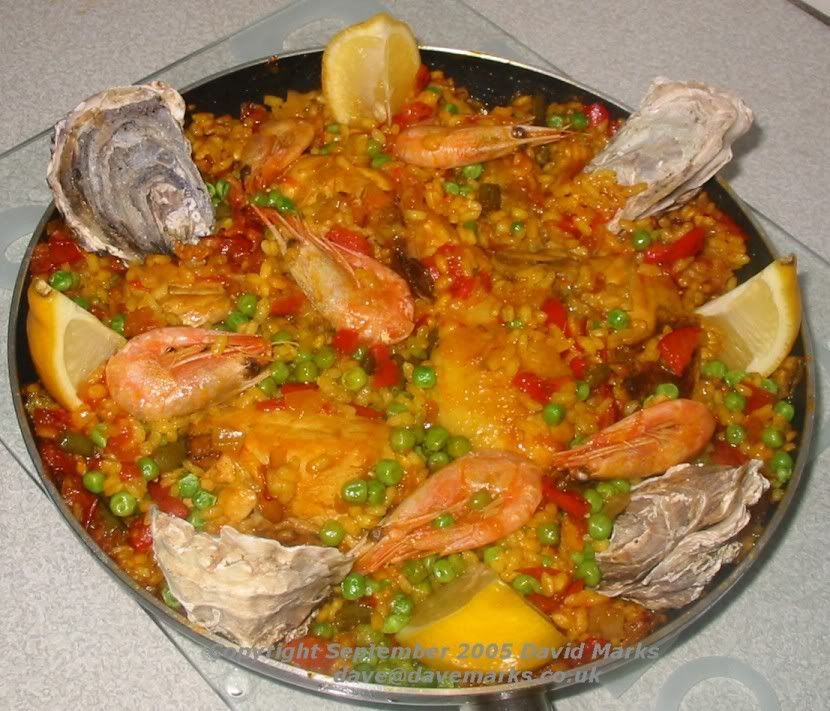
Prawns!Green peas!!Chicken!!Oyster!!Cheese!! and Much Much more!!Yum!!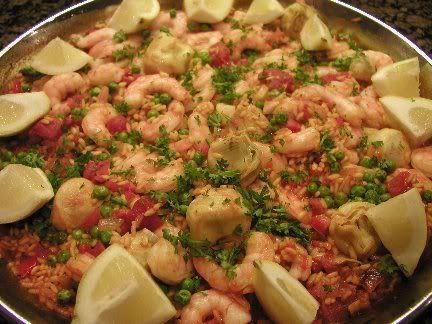
Now...that's really attractive...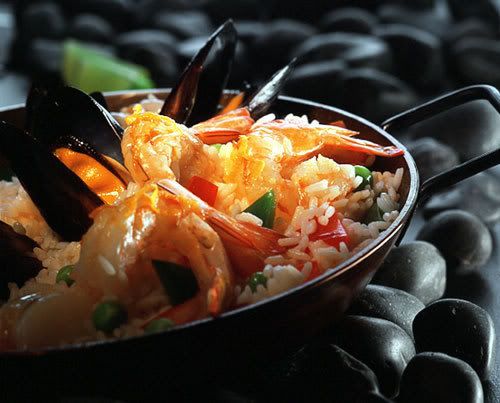
Seafood Paella!!
Small Paella!!
Vegilicious!!
Roundie the Doughnuts^^
I'm sure most everyone of us knows what doughnut is...
It has two meanings which are as follows :
1. A small ring-shaped cake made of rich, light dough that is fried in deep fat. Also called olicook.
Something whose form is reminiscent of a ring-shaped cake.
2. A fast, tight 360° turn made in a motor vehicle or motorized boat.
But what I'm talking about is a ring-shaped cake.
This explains how Americans love doughnuts...
Homer Simpsons is day dreaming about the doughnut...
Doughnuts recipe
1 cup granulated sugar
3 1/2 teaspoons baking powder
1/2 teaspoon cinnamon
1/2 teaspoon nutmeg
1/2 teaspoon salt
4 cups all-purpose flour
(about)
2 eggs
1 cup milk
3 tablespoons melted butter
Fat (for deep-fat frying)
How to make them...
Sift together sugar, baking powder, cinnamon, nutmeg, salt, and flour.
Beat eggs thoroughly, then stir into dry ingredients. Add the milk and melted butter. Roll about 1/2 inch thick on a floured board and cut with a doughnut cutter. Fry several at a time in 375 degrees F fat until nicely browned. Drain on paper towels. Dust with granulated or confectioners' sugar.
Makes 24.
Looks crispy...but you can't get it!!Muahahaha!!
I love them!!!
Kawaii Doughnuts!!All round ones....Yeah!!
Varieties of doughnuts!
It's the pink doughnut again!!Muah!
It's Dunkin' Donuts!
Dunkin' Donuts is an international coffee and donut retailer founded in 1950 in Quincy, Massachusetts, USA by William Rosenberg. It claims to be the "world's largest coffee and baked goods chain," serving 2.7 million customers per day at over 7,000 stores globally which includes approximately 5,300 Dunkin' Donuts locations in 34 states. This figure compares with the 10,800 stores of coffee chain Starbucks, whose baked goods are usually prepared out of shop. Most Dunkin' Donuts stores are franchises.
History Of Dunkin' Donuts
In 1946, William Rosenberg founded Industrial Luncheon Services as a company to deliver meals and "coffee break snacks" to customers in the outer reaches of Boston, Massachusetts. His business saw success and Rosenberg soon followed by opening up his first coffee and donut shop called "The Open Kettle". In 1950 he opened the first store known as "Dunkin' Donuts", which is still standing today at 543 Southern Artery in Quincy, Massachusetts. For a while, Dunkin' Donuts and its other quick-service brands - Togo's and Baskin Robbins - were owned and operated by Allied Domecq. Allied Domecq has since been bought out by Pernod Ricard for its Spirits and Wine division, breaking off the quick service brand to create Dunkin' Brands, the current owner of Dunkin' Donuts. Its biggest franchise can be found in Northvale, New Jersey. Currently, there are 5,505 Dunkin' Donuts franchises in the United States, 79 in Canada, and 1,856 throughout the rest of the world.
The policemen love the doughnuts...






